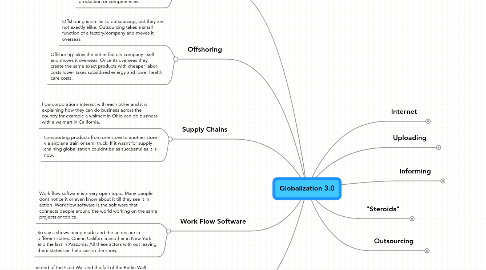Globalization 3.0
by Brandon pierce

1. Insourcing
1.1. Insourcing is defined as the delegation of operation or jobs from production within a business to an internal entity that specializes in that operation.
1.2. Insourcing is a busniess decision that is often made to maintain control of critical production or competencies.
2. Offshoring
2.1. Offshoring is similar to outsourcing, but they are not exactly alike. Outsourcing takes a small function of a factory/company and moves it overseas
2.2. Offshoring takes the entire factory company itself and moves it overseas. Once its overseas they create the same exact products with cheaper labor costs lower taxes subsidized energy and lower health care costs.
3. Supply Chains
3.1. how corporations interact with each other and it is explaining how they can do business across the country for example a walmart in Ohio can do business with a walmart in California.
3.2. transporting products from one store to another store via airplane train or semi truck. If it wasnt for supply chaining globalization couldnt be as successful as it is now.
4. Work Flow Software
4.1. Work flow software is a very open topic. Many people dont notice it or even know about it till they see it in action. Work flow software is the soft ware that connects people around the world working on the same projects or topics.
4.2. So say a shows being made and the actors are in different states. One in California another in New York and the last in Arazonia. All these actors with out leaving there states can help cast in the show.
5. End of Cold War
5.1. The end of the Cold War and the fall of the Berlin Wall opened the way for people to share their knowledge and flattened the alternatives to free market capitalism
5.2. It allowed the people to think about the world as a whole and become connected. The Cold War had been a struggle between capitalism and communism and the fall of the Berlin Wall eliminated the problem of two systems.
6. Internet
6.1. The World Wide Web was developed by British computer scientist Tim Berners-Lee. Its a system for creating, organizing, and linking documents so they could be easily browsed over the Internet.
6.2. The first Web site was in 1991. The First big breakthrough to bring the Internet alive as a tool of conectivity and colaboration was the World Wide Web. The internet is a network of networks, basically made from computers and cables.
7. Uploading
7.1. uploading allows anyone to upload to the Interent with information. Uploading has three parts Wikipedia, blogging/podcasting, and community-developed software.
7.2. Wikipedia allows people to get any type of info off a website. Blogging/podcasting shares info either for personal use or for anyone. Community-developed software allows things such as music and other files to upload to your computer.
8. "Steroids"
8.1. All technological content can be digitized, shaped, manipulated and transmitted virtualy.
8.2. Most mobile technology can be done anywhere, anytime by anyone. The first steriods ever were composed of computation capability, storage capability, and imput/output capablity.
9. Informing
9.1. Google and other search engines give people the ability to find information about any topic they want.
9.2. there are about one billion searches per day on google. it is up from 150 million just three years ago.
10. Outsourcing
10.1. Outsourcing is when companies take their work out of the United States so they can cut costs and save money. A lot of jobs are sent to places such as China, or India because their labor is cheaper than the United States labor.
10.2. There are many different types of outsourcing, including "fast food sourcing","homesourcing", "military",and " offshoring".


